Albert Hofmann
Jump to navigation
Jump to search
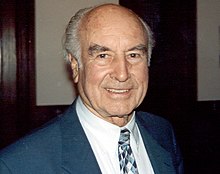
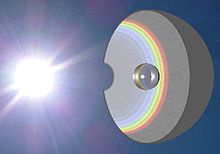
Albert Hofmann (11 January 1906 – 29 April 2008) was a Swiss scientist most famous for first synthesizing Lysergic acid diethylamide (LSD), and years later first experiencing its hallucinogenic effects.
Quotes[edit]
- I know LSD; I don't need to take it anymore. Maybe when I die, like Aldous Huxley.
- Outside is pure energy and colorless substance. All of the rest happens through the mechanism of our senses. Our eyes see just a small fraction of the light in the world. It is a trick to make a colored world, which does not exist outside of human beings.
- As quoted in "Nearly 100, LSD's Father Ponders His 'Problem Child'" (7 January 2006)
- It's very, very dangerous to lose contact with living nature. … In the big cities, there are people who have never seen living nature, all things are products of humans … The bigger the town, the less they see and understand nature.
- As quoted in "Nearly 100, LSD's Father Ponders his 'Problem Child." (7 January 2006)
LSD : My Problem Child (1980)[edit]
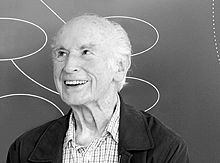


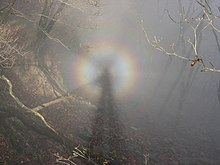
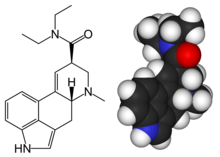


- There are experiences that most of us are hesitant to speak about, because they do not conform to everyday reality and defy rational explanation. These are not particular external occurrences, but rather events of our inner lives, which are generally dismissed as figments of the imagination and barred from our memory. Suddenly, the familiar view of our surroundings is transformed in a strange, delightful, or alarming way: it appears to us in a new light, takes on a special meaning. Such an experience can be as light and fleeting as a breath of air, or it can imprint itself deeply upon our minds.
One enchantment of that kind, which I experienced in childhood, has remained remarkably vivid in my memory ever since. It happened on a May morning — I have forgotten the year — but I can still point to the exact spot where it occurred, on a forest path on Martinsberg above Baden, Switzerland. As I strolled through the freshly greened woods filled with bird song and lit up by the morning sun, all at once everything appeared in an uncommonly clear light. Was this something I had simply failed to notice before? Was I suddenly discovering the spring forest as it actually looked? It shone with the most beautiful radiance, speaking to the heart, as though it wanted to encompass me in its majesty. I was filled with an indescribable sensation of joy, oneness, and blissful security.
I have no idea how long I stood there spellbound. But I recall the anxious concern I felt as the radiance slowly dissolved and I hiked on: how could a vision that was so real and convincing, so directly and deeply felt — how could it end so soon? And how could I tell anyone about it, as my overflowing joy compelled me to do, since I knew there were no words to describe what I had seen? It seemed strange that I, as a child, had seen something so marvelous, something that adults obviously did not perceive — for I had never heard them mention it.
While still a child, I experienced several more of these deeply euphoric moments on my rambles through forest and meadow. It was these experiences that shaped the main outlines of my world view and convinced me of the existence of a miraculous, powerful, unfathomable reality that was hidden from everyday sight.
- In studying the literature connected with my work, I became aware of the great universal significance of visionary experience. It plays a dominant role, not only in mysticism and the history of religion, but also in the creative process in art, literature, and science. More recent investigations have shown that many persons also have visionary experiences in daily life, though most of us fail to recognize their meaning and value. Mystical experiences, like those that marked my childhood, are apparently far from rare.
- Foreword
- I share the belief of many of my contemporaries that the spiritual crisis pervading all spheres of Western industrial society can be remedied only by a change in our world view. We shall have to shift from the materialistic, dualistic belief that people and their environment are separate, toward a new consciousness of an all-encompassing reality, which embraces the experiencing ego, a reality in which people feel their oneness with animate nature and all of creation.
- Foreword
- Deliberate provocation of mystical experience, particularly by LSD and related hallucinogens, in contrast to spontaneous visionary experiences, entails dangers that must not be underestimated. Practitioners must take into account the peculiar effects of these substances, namely their ability to influence our consciousness, the innermost essence of our being. The history of LSD to date amply demonstrates the catastrophic consequences that can ensue when its profound effect is misjudged and the substance is mistaken for a pleasure drug. Special internal and external advance preparations are required; with them, an LSD experiment can become a meaningful experience. Wrong and inappropriate use has caused LSD to become my problem child.
- Foreword
- 4/19/43 16:20: 0.5 cc of 1/2 promil aqueous solution of diethylamide tartrate orally = 0.25 mg tartrate. Taken diluted with about 10 cc water. Tasteless.
17:00: Beginning dizziness, feeling of anxiety, visual distortions, symptoms of paralysis, desire to laugh.
Supplement of 4/21: Home by bicycle. From 18:00- ca.20:00 most severe crisis. (See special report.)
Here the notes in my laboratory journal cease. I was able to write the last words only with great effort. By now it was already clear to me that LSD had been the cause of the remarkable experience of the previous Friday, for the altered perceptions were of the same type as before, only much more intense. I had to struggle to speak intelligibly. I asked my laboratory assistant, who was informed of the self-experiment, to escort me home. We went by bicycle, no automobile being available because of wartime restrictions on their use. On the way home, my condition began to assume threatening forms. Everything in my field of vision wavered and was distorted as if seen in a curved mirror. I also had the sensation of being unable to move from the spot. Nevertheless, my assistant later told me that we had traveled very rapidly. Finally, we arrived at home safe and sound, and I was just barely capable of asking my companion to summon our family doctor and request milk from the neighbors.
In spite of my delirious, bewildered condition, I had brief periods of clear and effective thinking — and chose milk as a nonspecific antidote for poisoning.- Describing his first deliberate ingestion of LSD on the 19th of April 1943, in Ch. 1 : How LSD Originated
- I was seized by the dreadful fear of going insane. I was taken to another world, another place, another time. My body seemed to be without sensation, lifeless, strange. Was I dying? Was this the transition? At times I believed myself to be outside my body, and then perceived clearly, as an outside observer, the complete tragedy of my situation. I had not even taken leave of my family (my wife, with our three children had traveled that day to visit her parents, in Lucerne). Would they ever understand that I had not experimented thoughtlessly, irresponsibly, but rather with the utmost caution, and that such a result was in no way foreseeable? My fear and despair intensified, not only because a young family should lose its father, but also because I dreaded leaving my chemical research work, which meant so much to me, unfinished in the midst of fruitful, promising development. Another reflection took shape, an idea full of bitter irony: if I was now forced to leave this world prematurely, it was because of this lysergic acid diethylamide that I myself had brought forth into the world.
- Ch. 1 : How LSD Originated

- Slowly I came back from a weird, unfamiliar world to reassuring everyday reality. The horror softened and gave way to a feeling of good fortune and gratitude, the more normal perceptions and thoughts returned, and I became more confident that the danger of insanity was conclusively past.
Now, little by little I could begin to enjoy the unprecedented colors and plays of shapes that persisted behind my closed eyes. Kaleidoscopic, fantastic images surged in on me, alternating, variegated, opening and then closing themselves in circles and spirals, exploding in colored fountains, rearranging and hybridizing themselves in constant flux. It was particularly remarkable how every acoustic perception, such as the sound of a door handle or a passing automobile, became transformed into optical perceptions. Every sound generated a vividly changing image, with its own consistent form and color.- Ch. 1 : How LSD Originated

- This self-experiment showed that LSD-25 behaved as a psychoactive substance with extraordinary properties and potency. There was to my knowledge no other known substance that evoked such profound psychic effects in such extremely low doses, that caused such dramatic changes in human consciousness and our experience of the inner and outer world.
What seemed even more significant was that I could remember the experience of LSD inebriation in every detail. This could only mean that the conscious recording function was not interrupted, even in the climax of the LSD experience, despite the profound breakdown of the normal world view. For the entire duration of the experiment, I had even been aware of participating in an experiment, but despite this recognition of my condition, I could not, with every exertion of my will, shake off the LSD world. Everything was experienced as completely real, as alarming reality; alarming, because the picture of the other, familiar everyday reality was still fully preserved in the memory for comparison.
Another surprising aspect of LSD was its ability to produce such a far-reaching, powerful state of inebriation without leaving a hangover. Quite the contrary, on the day after the LSD experiment I felt myself to be, as already described, in excellent physical and mental condition.
I was aware that LSD, a new active compound with such properties, would have to be of use in pharmacology, in neurology, and especially in psychiatry, and that it would attract the interest of concerned specialists. But at that time I had no inkling that the new substance would also come to be used beyond medical science, as an inebriant in the drug scene. Since my self-experiment had revealed LSD in its terrifying, demonic aspect, the last thing I could have expected was that this substance could ever find application as anything approaching a pleasure drug.- Ch. 1 : How LSD Originated

- Of greatest significance to me has been the insight that I attained as a fundamental understanding from all of my LSD experiments: what one commonly takes as "the reality," including the reality of one's own individual person, by no means signifies something fixed, but rather something that is ambiguous — that there is not only one, but that there are many realities, each comprising also a different consciousness of the ego.
One can also arrive at this insight through scientific reflections. The problem of reality is and has been from time immemorial a central concern of philosophy. It is, however, a fundamental distinction, whether one approaches the problem of reality rationally, with the logical methods of philosophy, or if one obtrudes upon this problem emotionally, through an existential experience. The first planned LSD experiment was therefore so deeply moving and alarming, because everyday reality and the ego experiencing it, which I had until then considered to be the only reality, dissolved, and an unfamiliar ego experienced another, unfamiliar reality. The problem concerning the innermost self also appeared, which, itself unmoved, was able to record these external and internal transformations.
Reality is inconceivable without an experiencing subject, without an ego. It is the product of the exterior world, of the sender and of a receiver, an ego in whose deepest self the emanations of the exterior world, registered by the antennae of the sense organs, become conscious. If one of the two is lacking, no reality happens, no radio music plays, the picture screen remains blank.

- What constitutes the essential, characteristic difference between everyday reality and the world picture experienced in LSD inebriation? Ego and the outer world are separated in the normal condition of consciousness, in everyday reality; one stands face-to-face with the outer world; it has become an object. In the LSD state the boundaries between the experiencing self and the outer world more or less disappear, depending on the depth of the inebriation. Feedback between receiver and sender takes place. A portion of the self overflows into the outer world, into objects, which begin to live, to have another, a deeper meaning. This can be perceived as a blessed, or as a demonic transformation imbued with terror, proceeding to a loss of the trusted ego. In an auspicious case, the new ego feels blissfully united with the objects of the outer world and consequently also with its fellow beings. This experience of deep oneness with the exterior world can even intensify to a feeling of the self being one with the universe. This condition of cosmic consciousness, which under favorable conditions can be evoked by LSD or by another hallucinogen from the group of Mexican sacred drugs, is analogous to spontaneous religious enlightenment, with the unio mystica. In both conditions, which often last only for a timeless moment, a reality is experienced that exposes a gleam of the transcendental reality, in which universe and self, sender and receiver, are one.
- Ch. 11 : LSD Experience and Reality
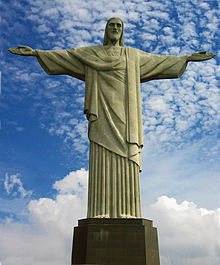
This promise constitutes the heart of my Christian beliefs and my call to natural-scientific research...

- The cultural-historical meaning of the Eleusinian Mysteries, their influence on European intellectual history, can scarcely be overestimated. Here suffering humankind found a cure for its rational, objective, cleft intellect, in a mystical totality experience, that let it believe in immortality, in an everlasting existence.
This belief had survived in early Christianity, although with other symbols. It is found as a promise, even in particular passages of the Gospels, most clearly in the Gospel according to John, as in Chapter 14:16-20. Jesus speaks to his disciples, as he takes leave of them:
- And I will pray the Father, and he shall give you another Comforter, that he may abide with you forever; Even the Spirit of truth; whom the world cannot receive, because it seeth him not, neither knoweth him: but ye know him; for he dwelleth with you, and shall be in you.
I will not leave you comfortless: I will come to you. Yet a little while, and the world seeth me no more; but ye see me: because I live, ye shall live also.
At that day ye shalt know that I am in my Father, and ye in me, and I in you.
- And I will pray the Father, and he shall give you another Comforter, that he may abide with you forever; Even the Spirit of truth; whom the world cannot receive, because it seeth him not, neither knoweth him: but ye know him; for he dwelleth with you, and shall be in you.
- This promise constitutes the heart of my Christian beliefs and my call to natural-scientific research: we will attain to knowledge of the universe through the spirit of truth, and thereby to understanding of our being one with the deepest, most comprehensive reality, God.
- Ch. 11 : LSD Experience and Reality

- As a path to the perception of a deeper, comprehensive reality, in which the experiencing individual is also sheltered, meditation, in its different forms, occupies a prominent place today. The essential difference between meditation and prayer in the usual sense, which is based upon the duality of creator-creation, is that meditation aspires to the abolishment of the I-you-barrier by a fusing of object and subject, of sender and receiver, of objective reality and self.
Objective reality, the world view produced by the spirit of scientific inquiry, is the myth of our time. It has replaced the ecclesiastical-Christian and mythical-Apollonian world view.
But this ever broadening factual knowledge, which constitutes objective reality, need not be a desecration. On the contrary, if it only advances deep enough, it inevitably leads to the inexplicable, primal ground of the universe: the wonder, the mystery of the divine — in the microcosm of the atom, in the macrocosm of the spiral nebula; in the seeds of plants, in the body and soul of people.- Ch. 11 : LSD Experience and Reality
- It could become of fundamental importance, and be not merely a transient fashion of the present, if more and more people today would make a daily habit of devoting an hour, or at least a few minutes, to meditation. As a result of the meditative penetration and broadening of the natural-scientific world view, a new, deepened reality consciousness would have to evolve, which would increasingly become the property of all humankind. This could become the basis of a new religiosity, which would not be based on belief in the dogmas of various religions, but rather on perception through the "spirit of truth." What is meant here is a perception, a reading and understanding of the text at first hand, "out of the book that God's finger has written" (Paracelsus), out of the creation.
The transformation of the objective world view into a deepened and thereby religious reality consciousness can be accomplished gradually, by continuing practice of meditation. It can also come about, however, as a sudden enlightenment; a visionary experience. It is then particularly profound, blessed, and meaningful. Such a mystical experience may nevertheless "not be induced even by decade-long meditation," as Balthasar Staehelin writes. Also, it does not happen to everyone, although the capacity for mystical experience belongs to the essence of human spirituality.- Ch. 11 : LSD Experience and Reality
- The characteristic property of hallucinogens, to suspend the boundaries between the experiencing self and the outer world in an ecstatic, emotional experience, makes it possible with their help, and after suitable internal and external preparation, as it was accomplished in a perfect way at Eleusis, to evoke a mystical experience according to plan, so to speak.
Meditation is a preparation for the same goal that was aspired to and was attained in the Eleusinian Mysteries. Accordingly it seems feasible that in the future, with the help of LSD, the mystical vision, crowning meditation, could be made accessible to an increasing number of practitioners of meditation
I see the true importance of LSD in the possibility of providing material aid to meditation aimed at the mystical experience of a deeper, comprehensive reality. Such a use accords entirely with the essence and working character of LSD as a sacred drug.- Ch. 11 : LSD Experience and Reality
MAPS interview (1998)[edit]

- I was visited by Timothy Leary when he was living in Switzerland many years ago. He was a very intelligent man, and quite charming. I enjoyed our conversations very much. However, he also had a need for too much attention. He enjoyed being provocative, and that shifted the focus from what should have been the essential issue. It is unfortunate, but for many years these drugs became taboo. Hopefully, these same problems from the Sixties will not be repeated.
- I believe that shortly after LSD was discovered, it was recognized as being of great value to psychoanalysis and psychiatry. It was not considered to be an escape. It was a very important discovery at that time, and for fifteen years it could be used legally in psychiatric treatment and for scientific study in humans. During this time, Delysid, the name I gave to LSD, was used safely, and was the subject of thousands of publications in the professional literature. Actually, just last week, I had visitors from the Albert Hofmann Foundation, to whom I gave all of the original documentation, which had been stored at the Sandoz Laboratories. This early work was very well documented, and shows how well research with LSD went until it became part of the drug scene in the 1960s. So, from originally being part of the therapeutic pharmacopeia, LSD became a drug of the street and inevitably it was made illegal. Because of this reputation, it became unavailable to the medical field, and so the research, which had been very open, was stopped. Now it appears that this research may start again. The importance of such investigations appears to be recognized by the health authorities, and so it is my hope that finally the prohibition is coming to an end, and the medical field can return to the explorations which were forced to stop thirty years ago.
LSD: The Geek's Wonder Drug? (2006)[edit]
- Quotes of Hofmann from "LSD: The Geek's Wonder Drug?" in WIRED magazine (16 January 2006)

- LSD wanted to tell me something. … It gave me an inner joy, an open mindedness, a gratefulness, open eyes and an internal sensitivity for the miracles of creation.
- Address on the first day of LSD: Problem Child and Wonder Drug, an International Symposium on the Occasion of the 100th Birthday of Albert Hofmann (13 January 2006)
- When you study natural science and the miracles of creation, if you don't turn into a mystic you are not a natural scientist.
- I think that in human evolution it has never been as necessary to have this substance LSD … It is just a tool to turn us into what we are supposed to be.
Quotes about Hofman[edit]
- When Hofmann synthesized the chemical in LSD, he stumbled upon a 4,000-year-old secret.
- Carl A. P. Ruck, The Road to Eleusis (1978) by R. Gordon Wasson, Albert Hofmann, and Carl A. P. Ruck

